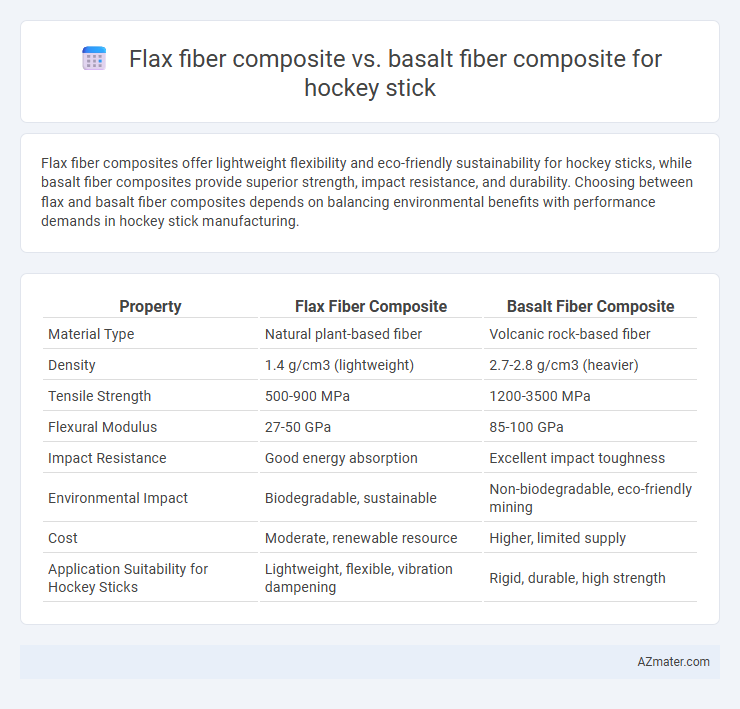Flax fiber composites offer lightweight flexibility and eco-friendly sustainability for hockey sticks, while basalt fiber composites provide superior strength, impact resistance, and durability. Choosing between flax and basalt fiber composites depends on balancing environmental benefits with performance demands in hockey stick manufacturing.
Table of Comparison
| Property | Flax Fiber Composite | Basalt Fiber Composite |
|---|---|---|
| Material Type | Natural plant-based fiber | Volcanic rock-based fiber |
| Density | 1.4 g/cm3 (lightweight) | 2.7-2.8 g/cm3 (heavier) |
| Tensile Strength | 500-900 MPa | 1200-3500 MPa |
| Flexural Modulus | 27-50 GPa | 85-100 GPa |
| Impact Resistance | Good energy absorption | Excellent impact toughness |
| Environmental Impact | Biodegradable, sustainable | Non-biodegradable, eco-friendly mining |
| Cost | Moderate, renewable resource | Higher, limited supply |
| Application Suitability for Hockey Sticks | Lightweight, flexible, vibration dampening | Rigid, durable, high strength |
Introduction to Flax and Basalt Fiber Composites
Flax fiber composites are derived from natural flax plant fibers, offering lightweight, renewable, and eco-friendly properties with good tensile strength and impact resistance suitable for hockey sticks. Basalt fiber composites are produced from volcanic basalt rock, providing superior mechanical performance, higher thermal stability, and excellent vibration damping compared to traditional glass fibers. The choice between flax and basalt fiber composites affects the stick's balance of sustainability, durability, and performance characteristics crucial for hockey players.
Material Properties Overview
Flax fiber composites provide excellent flexibility and lightweight characteristics with a tensile strength around 345 MPa, making them ideal for shock absorption in hockey sticks. Basalt fiber composites exhibit higher stiffness and superior impact resistance, with tensile strength reaching approximately 2800 MPa and a density near 2.7 g/cm3, enhancing durability during intense gameplay. The choice between flax and basalt fibers affects the stick's performance balance between flexibility, strength, and weight optimization.
Manufacturing Processes Compared
Flax fiber composites for hockey sticks typically involve wet layup or vacuum infusion methods that prioritize sustainability and lower energy consumption, whereas basalt fiber composites require higher temperature curing processes, often using autoclave or compression molding for enhanced thermal stability and mechanical strength. The manufacturing of flax composites benefits from faster cycle times and less specialized equipment, contributing to reduced production costs and environmental impact. In contrast, basalt fiber composites demand more precise control over temperature and pressure, resulting in superior durability and stiffness but increased complexity and expense in manufacturing.
Strength and Durability Analysis
Flax fiber composites exhibit impressive tensile strength and flexibility, making them suitable for hockey sticks requiring a balance of lightweight and shock absorption. Basalt fiber composites offer superior durability and higher impact resistance due to their dense mineral composition, enhancing the stick's lifespan and performance during intense gameplay. Comparative analyses show basalt composites outperform flax in mechanical strength metrics, positioning them as a robust choice for hockey sticks subjected to rigorous use.
Weight and Flexibility Differences
Flax fiber composite hockey sticks offer a lighter weight compared to basalt fiber composites, enhancing player agility and stick handling precision. Basalt fiber composites provide superior flexibility and vibration damping, resulting in improved shot control and comfortable impact absorption. Choosing between these materials depends on prioritizing either lightweight performance with flax or enhanced flex and durability with basalt fiber composites.
Environmental Impact and Sustainability
Flax fiber composites exhibit a lower environmental impact than basalt fiber composites due to their renewable, biodegradable nature and lower energy consumption during production, making them a more sustainable choice for hockey sticks. Basalt fiber composites, while offering excellent strength and durability, involve energy-intensive processing and are less biodegradable, resulting in higher ecological footprints. The use of flax fibers aligns with circular economy principles by facilitating easier recycling and reducing carbon emissions across the product lifecycle.
Cost and Market Availability
Flax fiber composites offer a cost-effective alternative to basalt fiber composites for hockey sticks, often priced lower due to the natural origin and more established supply chains. Basalt fiber composites, while generally more expensive, provide enhanced strength and durability but suffer from limited market availability and fewer suppliers. The greater accessibility and affordability of flax fiber composites make them a popular choice for cost-sensitive manufacturers and consumers in the hockey stick market.
Performance in Hockey Stick Applications
Flax fiber composites offer excellent vibration damping and lightweight properties, enhancing player control and reducing fatigue during extended use in hockey sticks. Basalt fiber composites deliver superior tensile strength and impact resistance, providing increased durability and power transfer for high-performance play. The choice between flax and basalt fiber composites depends on the balance between flexibility, weight, and robustness required for specific hockey stick applications.
Player Feedback and User Experience
Flax fiber composites in hockey sticks are praised for their lightweight flexibility and natural vibration damping, which enhances player control and reduces fatigue during extended play. Basalt fiber composites offer superior stiffness and impact resistance, providing players with powerful shot accuracy and durability under aggressive conditions. User feedback often highlights flax's comfort and feel, while basalt is favored for robust performance and longevity.
Future Trends in Hockey Stick Materials
Flax fiber composites offer lightweight, eco-friendly advantages with excellent vibration damping, making them increasingly popular for sustainable hockey stick manufacturing. Basalt fiber composites provide superior strength, impact resistance, and thermal stability, positioning them as a strong contender for high-performance hockey sticks. Future trends indicate a growing integration of hybrid composites combining flax and basalt fibers to balance durability, weight, and environmental impact in hockey stick materials.

Infographic: Flax fiber composite vs Basalt fiber composite for Hockey stick
 azmater.com
azmater.com